|

Introduction
We seem to have spent a good part of 2015
reviewing new gaming screens as they've emerged on the market, and we do intend
to start looking at some more mainstream and generalist monitors in 2016 when we
can. The reason for this has been such a big focus on gaming developments in the
monitor market last year, with new innovations like variable refresh rate
(G-sync and FreeSync) being launched, and big changes in refresh rates, blur
reduction technologies and screen size. In July last year we reviewed
Acer's 34" XR341CK monitor which boasted an overclocked IPS panel (75Hz
max), FreeSync support and a 34" ultra-wide, curved screen. This was
followed later in September by the G-sync-ready
Predator X34 model of the same size and format, but with 100Hz
overclocked refresh rate as well.
There's certainly been a push for bigger gaming screens last year, and an additional push to offer higher refresh
rates as well. We now have Acer's new Predator Z35 monitor with us for review.
This is a 35" ultra-wide screen with a curved VA panel. The refresh rate is
natively 144Hz but this screen can even be overclocked up to a whopping 200Hz.
It's been combined with NVIDIA G-sync capabilities and additionally their ULMB
(Ultra Low Motion Blur) backlight system. Clearly it's designed with gamers in
mind and offers some impressive specs and features which are bound to attract
attention. We will have a look at how all these features perform during the
course of this review.
If you appreciate the review
and enjoy reading and like our work, we would welcome a
donation
to the site to help us continue to make quality and detailed reviews for you. We
worked overtime to bring you this review nice and quickly as we know how excited
people were to see how this screen performs.
|
Check Pricing and Buy - Direct Links
|
|
Amazon USA |
Amazon UK |
Overclockers UK |
Amazon GER |
Amazon CAN
|
|
TFTCentral is a participant
in the Amazon Services LLC Associates Programme, an affiliate
advertising programme designed to provide a means for sites to earn
advertising fees by advertising and linking to Amazon.com, Amazon.co.uk,
Amazon.de, Amazon.ca and other Amazon stores worldwide. We also
participate in a similar scheme for Overclockers.co.uk. |

Specifications and Features
The following table gives detailed information
about the specs of the screen:
|
Monitor
Specifications |
|
Size |
35"WS |
Panel Coating |
Light AG coating |
|
Aspect Ratio |
21:9 curved 2000R |
Interfaces |
1x DisplayPort 1.2a
1x HDMI 1.4
|
|
Resolution |
2560 x 1080 |
|
Pixel Pitch |
0.320 mm |
Design
colour |
Matte black bezel and stand with some dark red
trim |
|
Response Time |
4ms G2G |
Ergonomics |
Tilt, 130mm height |
|
Static Contrast Ratio |
2000:1 |
|
Dynamic Contrast Ratio |
100 million:1 |
VESA Compatible |
No |
|
Brightness |
300 cd/m2 |
Accessories |
Power brick and cable, DisplayPort, HDMI and USB cables |
|
Viewing Angles |
178 / 178 |
|
Panel Technology |
AU Optronics AMVA (VA type) |
Weight |
net: 12.7Kg |
|
Backlight Technology |
W-LED |
Physical Dimensions |
(WxHxD) with stand:
844.4 x 554.5 - 684.5 x 299.9 mm |
|
Colour Depth |
16.7m |
|
Refresh Rate |
144Hz native
Up to 200z max overclocked |
Special
Features |
4x USB 3.0 ports (1 with fast charging), headphone port, NVIDIA
G-sync, ULMB, 2x 9W speakers, ambient light system |
|
Colour Gamut |
Standard gamut
~sRGB, ~72% NTSC |
The Predator Z35 offers a limited range of
connectivity options given the use of a G-sync module. However, these have
improved since the early G-sync capable screens which only featured a single
DisplayPort interface. This model offers DP 1.2a and an additional HDMI 1.4
input as well which is useful. The digital interfaces are HDCP certified for
encrypted content and the video cables are provided in the box for DisplayPort
and HDMI, along with a USB cable.
The screen has an external power supply brick
which comes
packaged along with the power cable you need. There are also 4x USB 3.0 ports,
located on the back of the screen next to the video and power
connections. One has charging capabilities as well. There are also some 2x
9W
DTS sound integrated speakers, and also an audio-out port but no further extras like card readers, ambient light sensors or human motion sensors
provided as those are more aimed at office uses, while this is primarily a
gaming screen.
Below is a summary of the features and connections
of the screen:
|
Feature |
Yes / No |
Feature |
Yes / No |
|
Tilt adjust |
 |
DVI |
 |
|
Height adjust |
 |
HDMI |
 |
|
Swivel adjust |
 |
D-sub |
 |
|
Rotate adjust |
 |
DisplayPort |
 |
|
VESA compliant |
 |
Component |
 |
|
USB 2.0 Ports |
 |
Composite |
 |
|
USB 3.0 Ports |
 |
Audio connection |
 |
|
Card Reader |
 |
HDCP Support |
 |
|
Ambient Light Sensor |
 |
MHL Support |
 |
|
Human Motion Sensor |
 |
Integrated Speakers |
 |
|
Touch Screen |
 |
PiP / PbP |
 |
|
Factory Calibration |
 |
Blur Reduction Mode |
 |
|
Hardware calibration |
 |
G-Sync |
 |
|
Uniformity correction |
 |
FreeSync |
 |

Design and Ergonomics

Above: front view of the screen. Click for larger version
The Predator Z35 comes in a mostly black design
with matte plastics used, and some dark red trim in places. The bezel
feels a bit chunky compared with some borderless screens we've tested of
late, with it measuring ~14mm along the top and sides and 25mm along the
bottom edge. To be honest it's not that big though. There is a 'Predator' logo in the middle of the bottom bezel,
and an 'acer' logo in the top left hand corner. The curve is more
pronounced than the X34 and we felt on a screen this size it worked well,
adding to the feeling of immersion.


Above: rear
views of the screen
The back of the screen is mostly finished in
a matte black plastic. There is a large shiny Predator logo here and some
areas at the top and bottom with red plastic trim. This gives a nice
contrast and makes the screen stand out (as if the 35" size wasn't
enough!) The stand is big and chunky and is covered in a mixture of matte
black and dark silver plastic sections. There are more red trim sections
on the base as you can see from the images. Unfortunately the stand cannot
be removed and so the screen is not VESA compliant.
Correction thanks to a reader: the
Z35 doesn't have an easy-access or quick-remove VESA 100 option sadly, but
it is possible to remove the stand and reveal some VESA 100
mounting holes if you really want to.
If you look at the attachment in the back of the monitor there is a
contour from some plastic which are two pieces that can be removed. The
piece snaps in so you pull it out and it snaps off although there is a
risk of breaking the plastic sections potentially.
Once the two plastic pieces are removed you
can unscrew the monitor stand and have the regular VESA 100 mounting holes
exposed. The backside of the monitor is shaped in a V-like fashion so you
can’t have a VESA-mount that is using long vertical rails (as typically
seen on monitor stands that accept VESA 100/200/400 attachments)—you need
a VESA 100 attachment with an extension so you get enough distance between
the back of the monitor and the monitor stand. All in all, not a very easy
to use option which is probably why they didn't make the stand easy to
remove and don't officially talk about a VESA mounting option.

Above: view
of the base of the stand
The base of the screen is shown above closer
up. There is a cable tidy hole in the base of the stand as well. The stand provides a big, solid and sturdy base for the heavy
screen with very little wobble at all. It's quite deep at about 280mm so
you will need a fairly deep desk to be able to accommodate it at a
comfortable viewing distance.
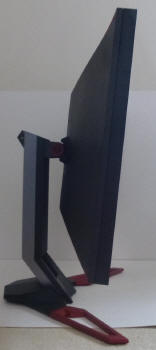
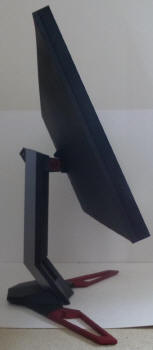
Above: full
range of tilt adjustment shown. Click for larger versions
The tilt function is smooth but quite stiff to move, but it does offer a
very wide range of angles to choose from as
shown above. Height adjustment is also smooth but very stiff
to move first of all, to the point of almost having to force it to get it moving at
all. In fact we didn't realise it even had a height adjustment first of
all. At the lowest height setting the bottom edge of the
screen is approximately 40mm from the edge of the desk. At the maximum
setting it is ~170mm, and so there is a 130 mm total adjustment range
available here. There are no side to side swivel or rotate adjustments
offered. Swivel would have been handy since the base is heavy and you
can't really re-position the base very often without it being a pain.
Rotation into portrait mode would have been impractical on a screen this
size anyway so isn't missed.
A summary of the screens ergonomic adjustments
is shown below:
|
Function |
Range |
Smoothness |
Ease of Use |
|
Tilt |
Yes |
Smooth |
Quite stiff |
|
Height |
130mm |
Smooth |
Very Stiff |
|
Swivel |
n/a |
- |
- |
|
Rotate |
n/a |
- |
- |
|
Overall |
Modest range of adjustments
offered, although stiff to move. |
The materials were of a reasonable standard and
the build quality felt good. It was a bit chunky and industrial in feel and
design we thought, but it's a big screen and you don't really want it to be
too flimsy! The whole screen remained
cool even during prolonged which was pleasing.
he bottom underside edge at the back of the screen provides the
video connections. There are only DisplayPort 1.2a and HDMI 1.4
inputs on this model given the use of NVIDIA G-sync. With it being a G-sync V
II module, HDMI is at least provided to give you some further flexibility
which is nice. Only the DP can support the high refresh rates and G-sync
though. Next to the video inputs there is also the power connection (external brick
provided) and headphone out. On the back of the screen itself are 1x USB upstream and 4x USB 3.0 ports (1 with charging
capabilities). The USB ports are a little easier to
access given their location on the back. It would have been even nicer if they'd have been on the edge of the
screen.
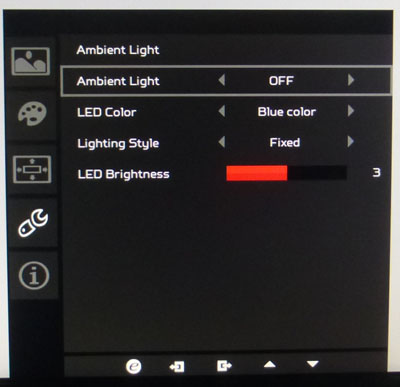
The screen features an ambient light feature
which we quite liked. Not something we've seen before on other screens before
we tested the XR341CK and X34 last year, but a
fairly nifty idea we thought. An LED strip of lights is located along most of
the bottom edge of the screen which can be controlled via the OSD menu as
shown above. When turned on you can change the colour and style of this light,
which provides a nice attractive glow beamed on to the desk below. The colour
can be changed to red, green, blue, white, orange, a random setting and also 'MNT
status' (whatever that means!). You can also change the style of the light,
whether it's fixed on, breathing, flashing, or ripple. The ripple is quite
nice, moving from end to end like the light on the front of KITT in Knight
Rider (old school 80's reference!) You can also change the brightness in
settings from 1 - 5, and whether the LED stays on when the screen is asleep.

OSD Menu

Above: OSD control buttons on the underside edge of the screen. Click for
larger version
The OSD menu is accessed and controlled through a
series 5 pressable buttons, along with a power on/off button. This power button
glows blue during normal operation and amber in standby. These are all
located on the underside edge of the screen in the bottom right hand corner.
There are no labels on the front of the screen so sometimes it's a bit tricky to
know which button you are pressing. The menu design is similar to what we saw
from the
Acer Predator X34.
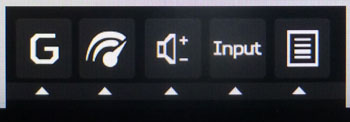
Pressing any of the buttons brings up the first
quick launch menu as shown above. From here you can access (from left to right)
the game modes, OD overdrive setting, volume control, input selection and then
the main menu.
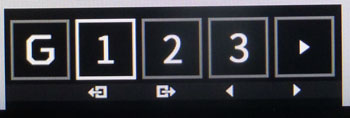

If you've entered into the game modes, pressing
the same buttons brings up a slightly different quick launch menu. Instead you
now have access to the 3 saveable modes, or you can scroll right to get to the
other options as before. While we're on the subject of the game modes, we did
find that if you switch the game mode on, and then off again, when you go back
to your previous preset mode the settings have reverted back to default,
including the brightness control.
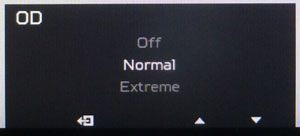

Some of the quick launch menus are shown above,
for OD mode and volume control. The input option just switches between DP and
HDMI without popping up any menu.
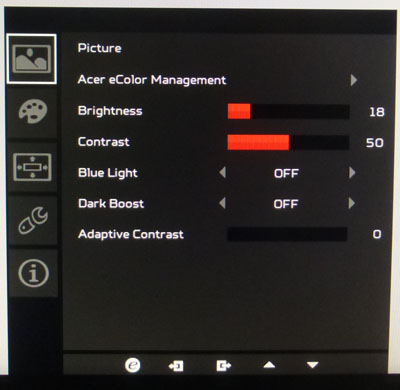
Entering the main menu provides you with a wealth
of options to play with. The menu is split down the left hand side into 5
sections, with options available in each shown on the right. At the bottom the
icons tell you what each button will now do within the menu. There is also
access to the 5 preset modes at the bottom via the 'e' icon. They are
basically just a series of 5 preset modes mostly down to different brightness
settings. If you change anything yourself in the OSD then it reverts you to the
'user' mode automatically so you can't really customise the modes how you want
unfortunately.
The first section
in the main OSD menu is the 'picture' menu with options for the eColor management preset modes,
brightness and contrast. The low blue light mode and dynamic contrast ratio (ACM)
are also provided here if you want to use them. Acer have added a "dark boost"
feature designed to boost the gamma in the darker tones which might be useful in
some games.
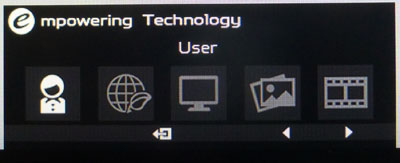
The eColor preset mode menu is shown above for
reference, with 5 modes available if you want.
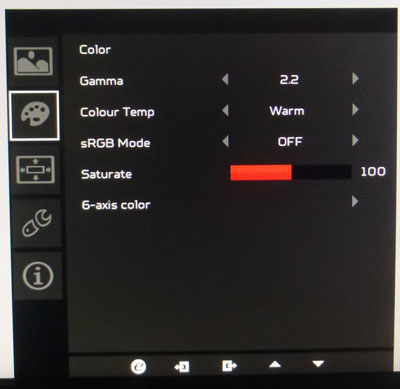
The second section is the 'color' menu contains
options for the gamma and colour temperature modes as well as adjustments for
the RGB levels for
calibration.
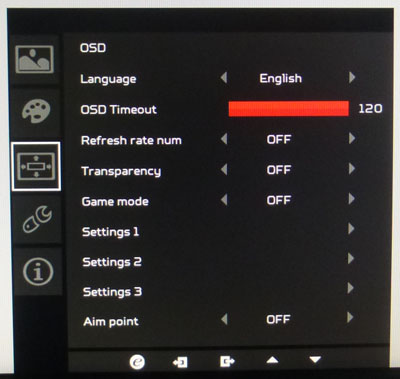
The third 'OSD' section has a few options relating
to the menu itself. You can also access a couple of gaming options to display
the refresh rate currently running in the top right hand corner (maybe handy when using
G-sync) and also an 'aim
point' for shooting games.
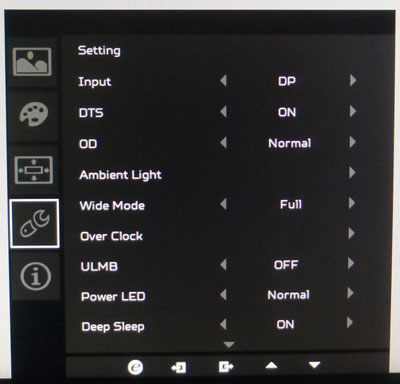
The 'setting' section has quite a few options in
it. You can control the OD
overdrive setting here
and the
overclocking feature. There is
also access to the ambient light feature which we looked at in the previous
section. Also included are options including
the aspect ratio modes.
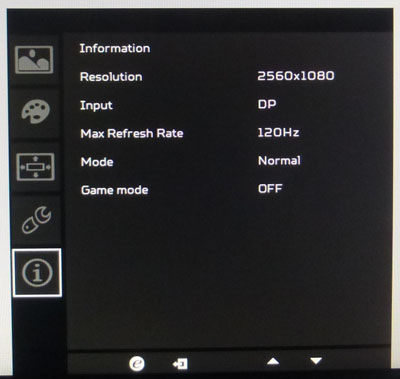
The final section contains a bit of info about the
current settings of the screen.
All in all the menu had a lot of options to play
with and the software looked nice and felt modern. It was a bit confusing to navigate sometimes
and not that intuitive, having to drill in to different levels and then using
lots of arrows back and forth. You sometimes find yourself having to go through
many button presses to get to an option you want.

Power Consumption
In terms of power consumption the manufacturer
lists typical usage of 47.0W, and 0.47W in standby. We carried out our normal tests to
establish its power consumption ourselves.
|
 |
|
State and Brightness
Setting |
Manufacturer Spec (W) |
Measured Power Usage
(W) |
|
Default (80%) |
47.0 |
66.5 |
|
Calibrated (21%) |
- |
42.0 |
|
Maximum Brightness (100%) |
- |
75.6 |
|
Minimum Brightness (0%) |
- |
34.9 |
|
Standby |
0.47 |
0.5 |
|
We tested this ourselves and found that out of the
box the screen used 66.5W at the default 80% brightness setting. Once calibrated
the screen reached 42.0W consumption, and in standby it used only 0.5W. We have
plotted these results below compared with other screens we have tested. The
calibrated consumption is very similar to the other larger format screens we've
tested like the Acer Predator X34 and LG 34UM95 for instance.


Panel and Backlighting
|
Panel Manufacturer |
AU Optronics |
Colour Palette |
16.7 million |
|
Panel Technology |
AMVA (VA-type) |
Colour Depth |
8-bit |
|
Panel Module |
M350DVR01.0 |
Colour space |
Standard gamut |
|
Backlighting Type |
W-LED |
Colour space coverage (%) |
~sRGB, ~72% NTSC |
Panel Part and Colour Depth
The Predator Z35 features an
AU Optronics M350DVR01.0 AMVA (VA-type) panel which is capable of producing
16.7 million colours through an 8-bit colour depth. You can actually make out
the panel label if you peer through the air vents on the back of the screen,
which was handy as it saved us having to open the screen up.
Screen
Coating
The
screen coating on the Predator Z35 is actually a little more grainy than we
expected. It's not quite as grainy as TN Film panels, which we would classify as
having a moderate coating, but it's not quite as light and clear as modern
IPS-type panels. Somewhere in the middle. It retains its anti-glare properties
to avoid too many unwanted reflections of a full glossy coating, but does not
produce an too grainy or dirty an image that some thicker AG coatings can. There
were no cross-hatching patterns visible on the coating but given the relatively
low resolution of a panel this size, you could pick out individual pixels if you
moved very close to the screen. Not a problem from a sensible viewing position
though.
Backlight Type and Colour Gamut
The screen uses a White-LED (W-LED) backlight unit
which has become very popular in today's market. This helps reduce power
consumption compared with older CCFL backlight units and brings about some
environmental benefits as well. The W-LED unit offers a standard colour gamut
which is approximately equal to the sRGB colour space.
Anyone wanting to work with wider colour spaces would need to consider wide
gamut CCFL screens or the newer range of GB-r-LED type displays available
now. If
you want to read more about colour spaces and gamut then please have a read of
our
detailed article.
Backlight
Dimming and Flicker
We tested the screen to establish the methods used
to control backlight dimming. Our in depth article talks in more details about a
common method used for this which is called
Pulse Width Modulation (PWM). This in itself gives cause for concern to some
users who have experienced eye strain, headaches and other symptoms as a result
of the flickering backlight caused by this technology. We use a photosensor +
oscilloscope system to measure backlight dimming control
with a high level of accuracy and ease. These tests allow us to establish
1) Whether PWM is being used to control the
backlight
2) The frequency and other characteristics at which this operates, if it is used
3) Whether a flicker may be introduced or potentially noticeable at certain
settings
If PWM is used for backlight dimming, the higher
the frequency, the less likely you are to see artefacts and flicker. The duty
cycle (the time for which the backlight is on) is also important and the shorter
the duty cycle, the more potential there is that you may see flicker. The other
factor which can influence flicker is the amplitude of the PWM, measuring the
difference in brightness output between the 'on' and 'off' states. Please
remember that not every user would notice a flicker from a backlight using PWM,
but it is something to be wary of. It is also a hard thing to quantify as it is
very subjective when talking about whether a user may or may not experience the
side effects.
100% 50%
0%



Above scale = 1
horizontal grid = 5ms
At 100% brightness a constant voltage is applied
to the backlight. As you reduce the brightness setting to dim the backlight a
Direct Current (DC) method is used, as opposed to any form of PWM. This applies
to all brightness settings from 100% down to 0%. The screen is flicker free as a
result, as advertised.
|
Pulse Width
Modulation Used |
No |
|
Cycling
Frequency |
n/a |
|
Possible
Flicker at |
|
|
100% Brightness |
No |
|
50% Brightness |
No |
|
0% Brightness |
No |
For an up to date list of all flicker-free (PWM free) monitors please see our
Flicker Free Monitor Database.

Contrast
Stability and Brightness
We wanted to see how much variance there was in
the screens contrast as we adjusted the monitor setting for brightness.
In theory, brightness and contrast are two independent parameters, and good
contrast is a requirement regardless of the brightness adjustment.
Unfortunately, such is not always the case in practice. We recorded the
screens luminance and black depth at various OSD brightness settings, and
calculated the contrast ratio from there. Graphics card settings were left at
default with no ICC profile or calibration active. Tests were made using an
X-rite i1 Display Pro colorimeter. It should be noted that we used the
BasICColor calibration software here to record these, and so luminance at
default settings may vary a little from the LaCie Blue Eye Pro report.
|
OSD
Brightness |
Luminance
(cd/m2) |
Black
Point (cd/m2) |
Contrast
Ratio
( x:1) |
|
100 |
359.37 |
0.12 |
2995 |
|
90 |
332.89 |
0.11 |
3026 |
|
80 |
306.02 |
0.11 |
2782 |
|
70 |
278.30 |
0.10 |
2783 |
|
60 |
249.71 |
0.09 |
2775 |
|
50 |
220.08 |
0.08 |
2751 |
|
40 |
189.29 |
0.07 |
2704 |
|
30 |
157.53 |
0.05 |
3151 |
|
20 |
124.59 |
0.04 |
3115 |
|
10 |
90.25 |
0.03 |
3008 |
|
0 |
54.42 |
<0.02 |
- |
|
Total Luminance Adjustment Range
(cd/m2) |
304.95 |
Brightness OSD setting controls backlight? |
 |
|
Total Black Point
Adjustment Range (cd/m2) |
>0.10 |
|
Average Static Contrast Ratio |
2909:1 |
PWM Free? |
 |
|
Recommended OSD setting
for 120 cd/m2 |
18 |
The brightness control gave us a very good range
of adjustment. At the top end the maximum luminance reached 359
cd/m2 which was
actually quite a lot higher than the specified maximum brightness of 300 cd/m2
from the manufacturer. This bodes well as the brighter the backlight is, the
brighter you can hope for when using the ULMB feature (tested
later on). There was a decent 305 cd/m2 adjustment
range in total, and so at the minimum setting you could reach down to a low
luminance of 54 cd/m2. This should be adequate for those wanting to
work in darkened room conditions with low ambient light. A setting of 18 in the OSD menu should return you a
luminance of around 120 cd/m2 at default settings.
It should be noted that the
brightness regulation is controlled without the need for
Pulse Width Modulation, using a Direct Current (DC) method for all
brightness settings between 100 and 0% and so the screen is flicker free as
advertised.

We have plotted the
luminance trend on the graph above. The screen behaves as it should in this
regard, with a reduction in the luminance output of the screen controlled by the
reduction in the OSD brightness setting. This is a linear relationship as you
can see.
The average contrast ratio of
the screen was excellent, with an average of 2909:1. Again, this surpassed the
spec of 2000:1 which was very pleasing. We have not provided the usual contrast
stability graph since rounding errors can come in to play at high contrast
ratios like this.

Testing
Methodology
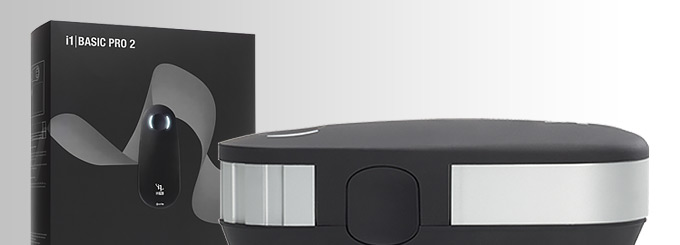
An
important thing to consider for most users is how a screen will perform out of
the box and with some basic manual adjustments. Since most users won't have
access to hardware colorimeter tools, it is important to understand how the
screen is going to perform in terms of colour accuracy for the average user.
We restored our graphics card to default settings
and disabled any previously active ICC profiles and gamma corrections. The
screen was tested at default factory settings using our new
X-rite i1
Pro 2 Spectrophotometer combined with
LaCie's Blue Eye Pro software suite. An X-rite i1 Display Pro colorimeter was
also used to verify the black point and contrast ratio since the i1 Pro 2
spectrophotometer is less
reliable at the darker end.
Targets for these tests are as follows:
-
CIE Diagram - validates the colour space
covered by the monitors backlighting in a 2D view, with the black triangle representing the
displays gamut, and other reference colour spaces shown for comparison
-
Gamma - we aim for 2.2 which is the default
for computer monitors
-
Colour temperature / white point - we aim
for 6500k which is the temperature of daylight
-
Luminance - we aim for 120
cd/m2, which is
the recommended luminance for LCD monitors in normal lighting conditions
-
Black depth - we aim
for as low as possible to maximise shadow detail and to offer us the best
contrast ratio
-
Contrast ratio - we aim
for as high as possible. Any dynamic contrast ratio controls are turned off here
if present
-
dE average / maximum -
as low as possible.
If DeltaE >3, the color displayed is significantly different from the
theoretical one, meaning that the difference will be perceptible to the
viewer.
If DeltaE <2, LaCie considers the calibration a success; there remains a
slight difference, but it is barely undetectable.
If DeltaE < 1, the color fidelity is excellent.

Default Performance and
Setup
Default settings of the screen were as follows:
|
Monitor OSD Option |
Default Settings |
|
Preset mode (eColor mode) |
Standard |
|
Brightness |
80 |
|
Contrast |
50 |
|
Colour Temp |
Warm |
|
RGB |
n/a |
|
Gamma |
2.2 |

Acer Predator Z35 - Default Settings





|
|
Default Settings |
|
luminance (cd/m2) |
338 |
|
Black Point (cd/m2) |
0.11 |
|
Contrast Ratio |
3063:1 |
Initially out of the box the screen was set in the
default 'standard' eColor preset mode. You could tell the screen was using a
standard gamut backlight and the image looked pretty good, but too bright for
comfortable use. Colour balance felt good and the image quality was decent. We went ahead and measured the default state with
the i1 Pro 2 device.
The
CIE diagram on the left of the image confirms that the monitors colour gamut
(black triangle) is roughly equal to the sRGB colour space. There is some minor
over-coverage, in most shades but not by anything significant.
Default gamma was recorded at 2.4 average, leaving it with a small 8% deviance
from the target which was not too bad. The screen has 2 gamma modes available in the
OSD and by default it was set to the 2.2 gamma level. We also tested the other
gamma modes for completeness and found the 1.8 mode returned a gamma average of
2.2 which was closer to your target (minor 2% deviance). We would recommend moving to the 1.8 gamma
mode in the OSD for a slightly better default setup:
Default setup
- 1.8 Gamma mode
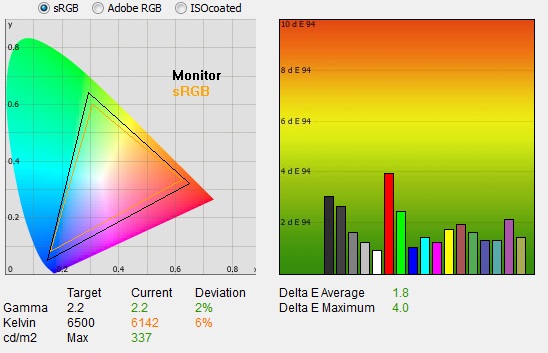

White point was measured at 6147k being slightly
too warm from the target of 6500k but with a low 5% deviance. The screen was set
in the default 'warm' colour temp mode incidentally. We again tested the other
modes which returned the following colour temperature results:
Colour Temperature Modes
|
OSD option |
Measured white point |
|
Cool |
10,237 |
|
Blue Light |
5391 |
|
User |
6147 |
|
Warm (Default) |
6147 |
The white point was probably best at the default
'warm' mode out of the box, and closest to our target of 6500k. The user mode is
identical but does give you access to the RGB channels to calibrate the screen
yourself. Note that the low blue light mode also has another setting in the
menu for levels of blue light reduction, defaulting to 70% when you enter that
mode. There's also options for 50, 60 and 80% available.
Luminance was recorded at a very bright 338
cd/m2 which is
too high for prolonged general use, and even beyond the specified 300 cd/m2
maximum. This is with the brightness control at only 80% as well. That is easy
to change of course to reach a more comfortable setting without impacting any
other aspect of the setup. The black depth was 0.11 cd/m2 at this default
brightness setting, giving us an excellent static contrast ratio of 3063:1,
again beyond the 2000:1 spec. This gives you deep, dark blacks which surpass
what is possible from IPS or TN Film screens.
Colour accuracy was also good out of the box
with a default dE average of 1.8 (once switched to the slightly better 1.8 gamma
mode), and a maximum of only 4.0. Testing the screen
with colour gradients revealed smooth
gradients with some gradation evident in darker tones as you see from most
screens. No banding issues visible thankfully.

Calibration
We used the
X-rite i1 Pro spectrophotometer combined with the LaCie Blue Eye Pro
software package to achieve these results and reports. An X-rite i1 Display Pro
colorimeter was used to validate the black depth and contrast
ratios due to lower end limitations of the i1 Pro device.
|
Monitor OSD Option |
Calibrated OSD settings |
|
eColor preset mode |
User |
|
Brightness |
21 |
|
Contrast |
50 |
|
Colour Temp |
User |
|
RGB Gain |
96, 93, 99 |
|
Gamma |
1.8 |

Acer Predator Z35 - Calibrated Settings


|
|
Calibrated Settings |
|
luminance (cd/m2) |
119 |
|
Black Point (cd/m2) |
0.04 |
|
Contrast Ratio |
2813:1 |
All the OSD
changes listed in the table above allowed us to obtain an
optimum hardware starting point and setup before software level changes would be
made at the graphics card level. When you enter the 'user' colour temp mode you
can drill in to it one more step to access the RGB channel gain controls. We left the LaCie software to calibrate
to "max" brightness which would just retain the luminance of whatever brightness
we'd set the screen to, and would not in any way try and alter the luminance at
the graphics card level, which can reduce contrast ratio. These adjustments
before profiling the screen would help preserve tonal values and limit
banding issues. After this we let the software carry out the LUT adjustments and create an
ICC profile.
Average gamma was now corrected to 2.2 average,
correcting the minor 2% deviance we'd seen out of the box (gamma mode 1.8). The
white point was now measured at 6513k
after adjustments to the RGB channels. Luminance had been improved thanks to the
adjustment to the brightness control and was now being measured at 119
cd/m2. This
left us a very low black depth of 0.04 cd/m2 and maintained an
excellent static contrast ratio of
2813:1 thanks to the VA panel. Colour accuracy of the resulting
profile was very good with dE average of 0.4.
Testing the screen with colour gradients revealed
mostly smooth gradients with some gradation evident in darker tones as you see
from most screens and some minor banding introduced in darker shades due to the
gamma corrections.
You can use our settings and
try our calibrated ICC profile if you wish, which are available in
our ICC profile database. Keep in mind that results will vary from one
screen to another and from one computer / graphics card to another.

Calibration Performance Comparisons

The comparisons made in this section try to give
you a better view of how each screen performs, particularly out of the box which
is what is going to matter to most consumers. When comparing the default factory
settings for each monitor it is important to take into account several
measurement areas - gamma, white point and colour accuracy. There's no point
having a low dE colour accuracy figure if the gamma curve is way off for
instance. A good factory calibration requires all 3 to be well set up. We have
deliberately not included luminance in this comparison since this is normally
far too high by default on every screen. However, that is very easily controlled
through the brightness setting (on most screens) and should not impact the other
areas being measured anyway. It is easy enough to obtain a suitable luminance
for your working conditions and individual preferences, but a reliable factory
setup in gamma, white point and colour accuracy is important and not as easy to
change accurately without a calibration tool.
From these comparisons we can also compare the
calibrated colour accuracy, black depth and contrast ratio. After a calibration
the gamma, white point and luminance should all be at their desired targets.

Default setup of the screen out of the box was
good overall. We'd recommend switching to the 1.8 gamma mode in the OSD which
then produces a better setup with an accurate gamma curve, strong static
contrast ratio and low dE. White point was slightly too
warm but only by a minor 5%
deviance and easy to correct through basic RGB adjustments in the OSD menu. With
those few basic OSD settings you have a strong setup which should suit most
users.


The display was very strong when it came to black depth
and contrast ratio thanks to its VA panel. With a calibrated contrast ratio
of 2813:1 it was comparable to some other VA panels in the market, in fact
exceeding our expectations based on the 2000:1 spec. It wasn't quite as high as
some other VA panels we've seen which can reach up to around 4000 - 5000:1 in
some cases, but at 2813:1 it was still excellent and far surpassing anything
possible with TN Film and IPS-type panels. This was certainly a strong point of
the Z35's VA panel.
|
Check Pricing and Buy - Direct Links
|
|
Amazon USA |
Amazon UK |
Overclockers UK |
Amazon GER |
Amazon CAN
|
|
TFTCentral is a participant
in the Amazon Services LLC Associates Programme, an affiliate
advertising programme designed to provide a means for sites to earn
advertising fees by advertising and linking to Amazon.com, Amazon.co.uk,
Amazon.de, Amazon.ca and other Amazon stores worldwide. We also
participate in a similar scheme for Overclockers.co.uk. |

Viewing Angles

Above: Viewing
angles shown from front and side, and from above and below. Click for
larger image
Viewing angles of the Z35 were a little
disappointing to be honest. The image behaved more like older generation VA
panels than some of the modern VA screens we've tested of late. From a side
angle, the image became washed out and yellow in appearance as you can
see. The same was visible from above and below. It reminded us of some older
generation VA panels such as that used in the
BenQ GW2750HM for instance. We had hoped for better, as we had seen
improvements in VA viewing angles with more recent models like the
BenQ GW2760HS and
BenQ BL3200PT for instance. So here, despite it being a brand new panel from
AU Optronics, it seems viewing angles have taken a bit of a step back. Perhaps
there's been less focus on this area with the push for high refresh rate support
and the new 35" curved format?
The viewing angles were still a bit better than TN
Film matrices, commonly used in gaming displays. There was a less pronounced
contrast shift vertically here. The colour tone and gamma shifts were more
noticeable of course than IPS-type panels, including the 34"
Acer Predator X34 as an example. Users should also be aware that the panel
exhibits the off-centre contrast shift which is inherent to the VA pixel
structure. When viewing a very dark grey font for example on a black background,
the font almost disappears when viewed head on, but gets lighter as you move
slightly to the side. This is an extreme case of course as this is a very dark
grey tone we are testing with. Lighter greys and other colours will appear a
little darker from head on than they will from a side angle, but you may well
find you lose some detail as a result. This can be particularly problematic in
dark images and where grey tone is important. It is this issue that has led to
many graphics professionals and colour enthusiasts choosing IPS panels instead,
and the manufacturers have been quick to incorporate this alternative panel
technology in their screens. We would like to make a point that for many people
this won't be an issue at all, and many may not even notice it. Remember, many
people are perfectly happy with their TN Film panels and other VA based screens.
Just something to be wary of if you are affected by this issue or are doing
colour critical work.
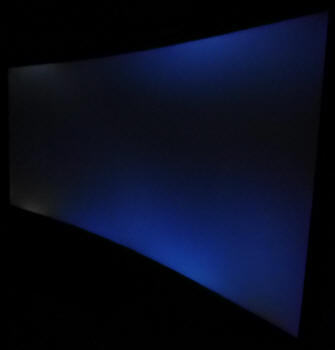
Above: View of an
all black screen from the side. Click for larger version
We captured a photo of an all-black image as
viewed from a side angle as shown above. This can help exhibit any glow you
might see on different panel technologies. Here, on the Z35 the actual glow
caused by the VA panel technology was quite low, with some pale areas picked up
in the photo. This side-angle photo actually captures some of the uniformity
issues we measured in the
following
section, and you can clearly see the darker and lighter areas of the screen.
From a head on viewing position this is hard to see, but viewing the screen from
a side angle accentuates it.

Panel Uniformity
We wanted to test
here how uniform the brightness was across the screen, as well as identify any
leakage from the backlight in dark lighting conditions. Measurements of the luminance
were taken at 36 points across the panel on a pure
white background. The measurements for luminance were taken using BasICColor's calibration
software package, combined with an X-rite i1 Display Pro
colorimeter with a central point on the screen calibrated to 120 cd/m2. The below uniformity diagram shows the difference, as a percentage,
between the measurement recorded at each point on the screen, as compared with the
central reference point.
It is worth
noting that panel uniformity can vary from one screen to another, and can depend
on manufacturing lines, screen transport and other local factors. This is only a
guide of the uniformity of the sample screen we have for review.

Uniformity of Luminance

The luminance uniformity of the screen was
not very good from our sample. We measured
two obviously darker regions of the screen on either side.
The luminance dropped off quite a lot down to 89
d/m2 in the most extreme cases. Only 36% of the screen remained
within a 10% deviance of a centrally calibrated 120 cd/m2 point
which was disappointing. Results will vary from sample to sample of course,
but the luminance uniformity was a bit of an issue on the sample we tested.
It didn't really cause any obvious problems in general day to day uses to be
honest.

Backlight Leakage

Above: All black screen in a darkened room. Click for larger version
As usual we also tested the screen with an all
black image and in a darkened room once the screen had been calibrated to a
sensible day to day
120 cd/m2.
A camera was used to capture the result from a distance of ~2m to limit any glow
which might be caused by viewing angles. The camera showed there was some slight
clouding and a bit of backlight bleed detected in the corners, but this was very
hard to notice with the naked eye at a calibrated brightness level. If you view
the screen from the side, you can pick out the areas of clouding more easily, as
we saw in the
previous section of the review. Day to day, from head-on we didn't see any
noticeable issues with bleed.

General and Office Applications
One of the key selling points of ultra-wide
screens like the this is normally the high resolution and large screen size.
Despite the 35" screen size on the Z35, the resolution is actually a lot lower
than one might like for office-type work. It's only 2560 x 1080 and so the
display has a large pixel pitch of 0.320mm and large fonts as a result. Text
looks big and less sharp than we are used to from common screens such as the
wide range of 27" 2560 x 1440 we use day to day. Smaller 34" models like Acer's
XR341CK and X34 are also able to offer up to 3440 x 1440 resolution and
so provide a sharper, clearer image thanks to their smaller 0.233 mm pixel
pitch; not to mention a much bigger desktop size to work with. So on the Z35,
this lower resolution is a draw-back when it comes to general desktop and office
type uses. We did get used to it after a little while, but the image just didn't
look as clear as higher resolution panels. You could still do some split screen
side by side working thanks to the 2560 horizontal resolution, but vertically it
was a bit limited. If you compare the pixel pitch of 0.320mm on this model with
other screens in the market, it's fairly comparable to some 27" models you can
find with 1920 x 1080 resolution. A 28" screen at 1080p would be a closer
comparison to how the text looks on the Z35. If office work is your main use, we
would probably suggest looking for a screen with a higher resolution. This is
purely aimed at gaming and we feel with the resolution being what it is, it
should probably be used for gaming and multimedia as much as possible and not
much else.
There is a reason for this lower resolution
though. Firstly Acer are limited by available panels produced by the key panel
manufacturers in the market. At the moment, the only 35" panels in production
are from AU Optronics and they only manufacturer them at 2560 x 1080. This is
linked to their native 144Hz refresh rate from the panel though, which would be
beyond bandwidth limitations of existing DisplayPort 1.2 connections if the
resolution was higher at 3440 x 1440. Not to mention the fact Acer have enabled
an overclock up to 200Hz which pushes that bandwidth requirement even further.
Perhaps with the arrival of
DisplayPort 1.3 later this year we might start to see high refresh panels
with higher resolutions as well. Added to this technical limitation is the
potential market for a screen like this. It would take a very powerful system to
reliably run a screen at 3440 x 1440 @ 200Hz, and so by limiting the resolution
to 2560 x 1080 they make this more achievable for more users. In fact, in gaming
you are less likely to notice the lower resolution than you might in desktop use
and so it becomes less of an issue.
The fairly light AG coating of the VA panel doesn't
produce any graininess to the image like some aggressive AG solutions can and so
white office backgrounds look fairly clean and clear, perhaps not quite as clear
as we had hoped. The
viewing angles of the
VA panel technology were not great sadly, and a step back from some other modern
VA panels we've tested in fact. You will notice fairly obvious contrast and
colour tone shifts if you move your line of sight around much of view the screen
from an angle. Some contrast shifts may be evident because of the very wide size
of the display, as you glance towards the edges from a centrally aligned
position. That's hard to avoid on such a large desktop monitor from close up.
The default setup of the screen was pretty good, and easy to tweak through the
OSD to get an even better performance. We were also pleased with the strong
~2900:1 contrast ratio as well which is certainly a strength of the VA panel.
The brightness
range of the screen was also very good, with the ability to offer a luminance
between 354 and 18 cd/m2. This should mean the screen is perfectly
useable in a wide variety of ambient light conditions, including darkened rooms.
A setting of ~18 in the OSD brightness control should return you a luminance
close to 120 cd/m2 out of the box. On another positive note, the brightness
regulation is controlled without the need for the use of the now infamous
Pulse-Width Modulation (PWM), and so those who suffer from eye fatigue or
headaches associated with flickering backlights need not worry.
There was no audible noise
or whistling noise from the screen. There is no specific preset mode for office
work or reading so you will have to set the user mode how you want. If you need
different settings for gaming you can save up to 3 user defined gaming modes as
well which is very handy. Even with the use of G-sync v II, the screen is
limited when it comes to connectivity options with only DP and HDMI available.
The screen offers 4x USB 3.0 ports which can be
useful and it was nice to keep this up to date with the modern version. One also
offers charging support but all of them are located on the back of the display so
are not easy-access really. Integrated 2x 9W speakers can provide sound for the odd
YouTube clip or mp3 if you want. There are no further extras like ambient light
sensors or card readers which can be useful in office environments. Remember,
this is aimed at gamers really. There was a reasonable range of ergonomic adjustments
available from the stand allowing you to obtain a comfortable position for a
wide variety of angles. They were mostly stiff though so you might not
want to move it around too often. We did miss swivel a bit though and the lack
of VESA
mounting support may also be off-putting to some people as well who wanted more flexibility.

Gaming Introduction

Several things make the Z35 stand out when it
comes to gaming:
-
Refresh Rate - the VA panel has a native
refresh rate support from AU Optronics of 144Hz so right away you know that the
panel should be able to achieve decent refresh rates without complications.
-
Overclocking - Acer have then enabled an
overclocking feature allowing you to overclock the screen up to 160, 180 or
200Hz maximum. This is quick and easy to achieve through the OSD menu. The
reason for the "up to" 200Hz message is because you can customise the maximum
refresh rate you want to select in the OSD, in 20Hz increments all the way up to
200Hz. We have been
told that overclocking does not affect the Acer warranty, which carries
standard warranty terms and is available via the Acer support website. We are told that once enabled in the OSD the
monitor will report back to your operating system the supported refresh
rates and it should not matter what graphics card vendor you are using.
Based on this you should be able to get 200Hz in most cases it seems.
Results may vary from system to system so you may have to limit yourself to
180Hz. Even without the overclocked refresh rate the native 144Hz is more than
adequate and very fast anyway.
-
NVIDIA G-sync - this higher refresh rate
support has been paired with an
NVIDIA G-sync module, offering G-sync variable refresh rate support between 30 and 144Hz,
or up to the maximum overclocked refresh rate if you select that. The overclocking facility of the screen seems to be related to the
presence of a G-sync module, or perhaps more precisely down to the absence of a
built-in scaler. G-sync brings about obvious benefits when it comes to gaming
and so is very welcome.
-
ULMB Blur Reduction - this has been
provided natively on this screen allowing users to operate a strobed backlight
if they wish, for noticeable motion blur reduction benefits. Have a read of
our full article about these technologies to understand the benefits in more
detail. On the Z35, ULMB can be enabled at 85, 100 and 120Hz refresh rate
settings (not 144Hz or above) but is not available when using G-sync.
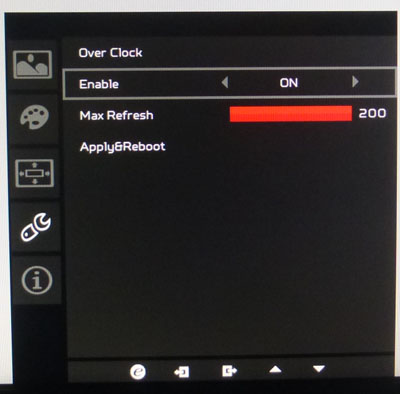
The screen is recognised by Windows as a 144Hz
panel by default, and that's the maximum you can select when you first connect
the screen. The support for higher refresh rates is enabled via the OSD menu
using the "over clock" feature as shown above. You enable this and the monitor
reboots itself. Once that's done, in Windows you then have further options
available to select for refresh rates up to 200Hz. We will test these higher
refresh rates during the following sections of this review, checking if any
frames are dropped and if there appear to be any side effects.
|
Ultra Wide screen format |
 |
|
VA-type panel technology |
 |
|
Max native refresh rate
support |
144Hz |
|
Max overclocked refresh rate support
|
Up to 200Hz |
|
G-sync support |
 |
|
Blur Reduction mode |
 |
|
NVIDIA 3D Vision |
 |
To make the most of this screen you will want to
have a
suitable NVIDIA graphics card which supports G-sync. That will allow you to use
two of the most interesting features of this screen, the G-sync support and
the ULMB feature.
Since the screen needs an additional G-sync module to make this function work,
there is an added cost to production.

Responsiveness and Gaming
|
Quoted G2G Response Time |
4ms G2G |
|
Quoted ISO Response Time |
n/a |
|
Panel Manufacturer and
Technology |
AU Optronics AMVA (VA-type) |
|
Panel Part |
M350DVR01.0 |
|
Overdrive Used |
Yes |
|
Overdrive Control Available to
User |
OD Mode |
|
Overdrive Settings |
Off, Normal, Extreme |
The Predator Z35 is rated by Acer as having a 4ms G2G response time, which indicates the panel uses
overdrive /
response time compensation (RTC) technology to boost pixel transitions
across grey to grey changes. There is user control over the overdrive impulse
within the OSD menu using the 'OD Mode' (overdrive) option. The
part
being used is the
AU Optronics M350DVR01.0 AMVA (VA-type)
panel. Have a read about response time in
our
specs section if you need additional information about this measurement.
We will first test the screen using our thorough
response time testing method. This uses an oscilloscope and photosensor to
measure the pixel response times across a series of different transitions, in
the full range from 0 (black) to 255 (white). This will give us a realistic view
of how the monitor performs in real life, as opposed to being reliant only on a
manufacturers spec. We can work out the response times for changing between many
different shades, calculate the maximum, minimum and average grey
to grey (G2G) response times, and provide an evaluation of any overshoot present
on the monitor.
We use an
ETC M526
oscilloscope for these measurements along with a custom photosensor device.
Have a read of
our response time measurement article for a full explanation of the testing methodology and reported
data.
Response Times and Refresh Rate

The Predator Z35 comes with a user control for the
overdrive impulse available within the OSD menu in the 'setting' section, as
well as via one of the quick launch options shown above. There are 3 options
available here under the OD Mode setting, as we've seen on other recent Acer
screens. First of all we carried out a fairly small set of measurements in all 3
of the OD Mode settings. These, along with various motion tests allowed us to
quickly identify which was the optimum overdrive setting for this screen. There
are some further important considerations when it comes to refresh rate which we
will look at as well.
OD Off



Firstly we tested the response times with OD set to
off, effectively turning off the overdrive impulse. These results remained
pretty consistent across all refresh rates with OD off. We know from some other
screens that the G-sync modules often seem to dynamically impact the response
times and overdrive impulse at different refresh rates and we expected the same
thing from this screen. With OD off here, there was no overdrive impulse to
control so the refresh rate made little difference to the actual pixel response
times. It did however have a big impact on motion clarity and blurring which we
will look at in a moment.
With OD off, the average response time was measured
at between 17 and 16ms G2G average which was very slow really. There were some transitions
which were extremely slow and problematic, for instance the 0-50 transition was
a whopping 56.5ms! In fact only the changes to white (x > 255) and to black (x >
0) were fast at around 6 - 8ms, with mid-tone transitions being slow at around
14 - 24ms. There was no overshoot in
this mode, but the response times were far too slow for gaming or fast moving
content. VA type panels have never been that fast, and without overdrive applied
they remain very slow as you can see here. We will come on to motion tests in a
moment.
OD Normal



Switching up to the 'Normal' OD mode brought about
some positive changes to response times. With overdrive now turned on,
there was some variation in performance depending on the refresh rate. Above we
can compare the pixel response times at 60Hz refresh rate and the native maximum
144Hz, and overclocked maximum 200Hz. At 60Hz the average G2G was a bit better at 13.9ms, but
still this was slow in certain circumstances. Some transitions still proved to be problematic. There
wasn't any overshoot introduced though so the overdrive impulse seemed to be
quite modest, at least at 60Hz refresh rate.
At 144Hz G2G average had reduced down to 11.4ms
now which was a bit better, but with some transitions still being very slow,
like those from black to grey shades (e.g. 0-50 and 0-150) there was still some
issues here. Some of the moderately slow transitions from the 60Hz measurements
had been sped up though which was good news and if we ignore the few problematic
transitions, the other response times were actually very good. The same thing
can be said for the overclocked 200Hz mode although there was very little
difference to the 144Hz setting overall in the response time measurements. We
will look at some motion blur tests in a moment. There was overshoot measured in
this small sample set at the higher refresh rates of 144Hz and above, getting
progressively more noticeable as a result of the overdrive impulse being
boosted. Our subsequent motion tests show further analysis as well in a moment.
OD Extreme



Finally we tested the 'Extreme' OD mode. There was
an improvement in measured response times again but it was not by a huge amount.
At 60Hz refresh rate they dropped from 13.9ms in normal mode down to 11.8ms, but
this was still slow overall because of some of the problematic transitions.
There was still an issue with a couple of very slow transitions from black to
grey (0-50 and 0-150) even with this maximum overdrive setting being used. There
was minimal overshoot introduced at 60Hz, again showing the overdrive impulse
was fairly modestly applied even while set at the 'extreme' setting.
At 144Hz refresh rate, the response times dropped down to 9.6ms
G2G average. Some transitions had been sped up now and only the 0-50 transition
remained a real problem. In fact, if we ignore that one transition the average
response times were more like 5.9ms G2G with some as low as 1.9ms which was very
good. However, to achieve these response times the overdrive impulse had to be
turned up very high and this lead to some high levels of overshoot, and obvious
dark and pale trails in motion tests.
The same thing can be said for the 200Hz setting.
Overall the average response time was now 8.9ms, but would be 5.0ms G2G if we
ignored the problematic 0-50 transition. Again to achieve these low numbers the
overdrive impulse was being applied too aggressively and so there were very high
levels of overshoot. This was again very obvious in practice.
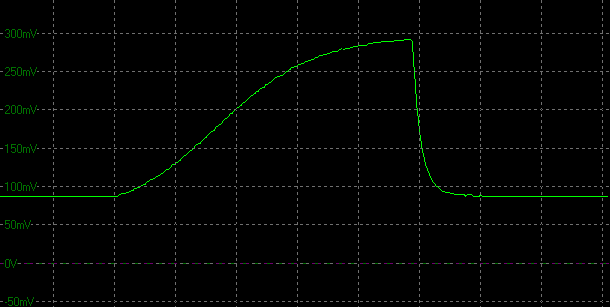
0-50-0 transition,
OD Extreme
scale = 20ms per horizontal grid
Above is the oscilloscope graph for the
problematic 0-50
transition. You can see the extremely slow rise time here, no matter what the OD
setting or refresh rate selected. Very slow indeed. Apart from a few problematic
transitions the other response times were mostly very good, but these
inconsistencies did cause some problems in practice.
So those tests measure the pixel response times in
each of the OD settings. With OD off, there was very little change in response
times at different refresh rate settings, since there was no overdrive impulse
being applied, and therefore no overdrive impulse to be dynamically altered by
the G-sync module. With OD pushed up to normal or extreme, there were some
modest improvements in response times, which were impacted a little with the
varying refresh rate. The slow response times in some transitions recorded for this screen
presented some problems as you increase the refresh rate unfortunately. We will
try to demonstrate that here, to give an idea of what you can see in practice running some simple motion tests. We used the familiar PixPerAn tool,
testing the screen in each of the OD settings and at a selection of refresh
rates from 60Hz all the way up to 200Hz (maximum overclock).
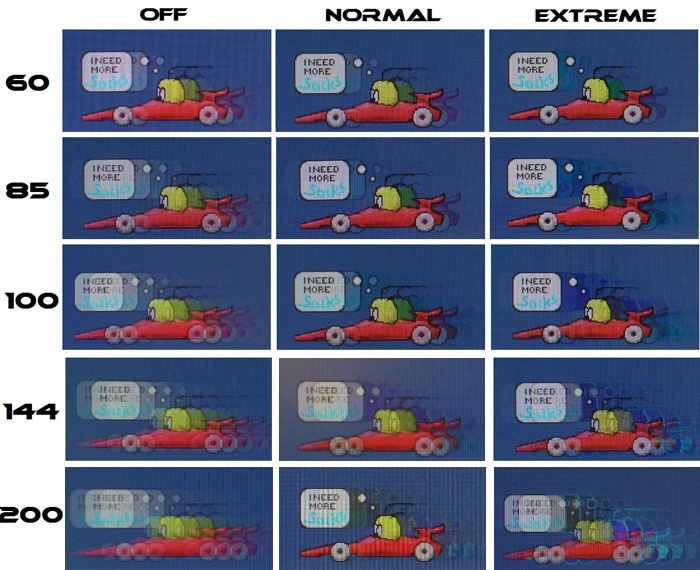
Let's concentrate first of all on the OD off
setting, and how the performance varies with changing refresh rates - look at
the first column in the above image. We know from our oscilloscope measurements
that there's very little change in actual pixel response times at different
refresh rate settings. As a reminder, we measured 16 - 17ms G2G average in that
mode, with some transitions being extremely slow indeed. Even though we know
response times are very similar at different refresh rates, you see something
different with the naked eye here. As you increase the refresh rate the motion
clarity gets progressively worse. By the time you reach the native 144Hz
maximum, or even the overclocked 200Hz maximum there is a massive amount of
blurring and the image is just a streaky, blurry mess. If response times aren't
changing, what is the reason for this?
The reason is that the response times aren't fast
enough to keep up with the frame rate of the higher refresh rate settings. For
example, at 85Hz there is a new frame displayed every 11.76ms. At 100Hz a new
frame every 10ms, at 144Hz every 6.94ms and at 200Hz every 5ms. To be able to
cope with the frame rate the response times of the panel need to be reliably and
consistently faster than those changes in frames. So for 85Hz operation you'd
need reliable response times of <11.76ms. If the response times aren't faster
than this then you are left with a lot of motion blur. You will see this from
many overclocked Korean models, where you can boost refresh rate often up to 100
- 120Hz, but on panels which are fundamentally slow. Here, it's a problem, as
with OD off we measured 16 - 17ms G2G average, with many transitions being much,
much slower. That's barely fast enough for 60Hz operation (a new frame every
16.66ms). So if you use OD off and increase the refresh rate on this screen to
anything above 60Hz, the motion clarity just gets worse and worse. So to
summarise, if you use OD off, don't go above 60Hz! Whether you'd ever lead OD
off is unlikely to be honest, so let's think more about the 'normal' and
'extreme' modes.
The OD normal mode is the middle column in the
image above. In that setting we saw some minor improvement in motion clarity as
you move from 60Hz to 85Hz and 100Hz. The moving image just looked a little
sharper and clearer, but not by much. This is a result of the slightly boosted
response times, along with motion clarity benefits of an increased refresh rate.
Some slight dark trailing began to appear but it was not too distracting or
severe. Levels of blurring varied depending on the content and colour
transitions, with
the response times measured at only 11.4ms G2G average (again with some very
slow examples). Some scenes were nice and smooth with low levels of smearing
where response times were low, but in certain circumstances a noticeable
smearing was introduced where the response times just couldn't keep up. This was
particularly evident on darker content. The motion clarity was certainly not as
smooth and clear as fast IPS and TN Film gaming panels overall. However, it was
good for a VA type panel on the most part.
As you move up to higher refresh rates like 144Hz and 200Hz the
behaviour changed somewhat. Ignoring the few very slow transitions, the rest of
the response times were just about fast enough to cope with 144Hz operation,
although by that time you could detect additional noticeable dark overshoot in this OD
normal mode since the overdrive impulse was now being applied more aggressively. As you increased to 200Hz the overshoot became more pronounced
again, but the blurring was a little less. With OD at normal, you can just about
get away with using the full range of refresh rates from a frame rate point of
view, although in some colour transitions you may see enhanced blurring caused
by the fact that some response times can't keep up with the frame rate demands.
In an ideal world you would be able to achieve response times reliably of
<6.94ms for 144Hz operation, and <5ms for 200Hz. Some transitions reached this
level, but some did not. Some were very slow indeed as we've mentioned. With the
added significant overshoot introduced at the higher refresh rates we question
the practical use of 144Hz and above refresh rates with OD set to normal for
some users.
We felt the screen was ok at up to around 100 - 120Hz without the
overshoot becoming distracting and noticeable. At these levels there was little
excess blurring or smearing introduced due to some slow pixel changes in most
cases, although some scenes showed problems. The overshoot was kept at fairly low levels
and not really a problem though up to 120Hz. Sadly we felt the panel was not capable of achieving
low enough response times to reliably support anything higher, including the
144Hz native maximum refresh rate, and the overclocked range from 160 - 200Hz.
The smearing becomes more obvious and the overdrive impulse starts to get applied too aggressively to try and keep up,
and so the resulting overshoot is a big problem. You might want to experiment with different settings above 120Hz perhaps,
although we felt the performance at 120Hz gave a better overall appearance.
Finally the OD extreme mode was tested, and really
we can only advise you to leave this setting alone. The response times are
mostly fast enough to allow operation at 144Hz without excess blurring and
smearing being introduced, as long as you ignore the few problematic transitions
like 0-50 (measured at 50ms at 144Hz). Even at 200Hz they are just about low
enough. The problem with OD extreme is that there's too much overshoot at
anything above 60Hz, and so you are left with dark trails and halos behind the
moving objects. They become very severe at higher refresh rates and so this
extreme mode should be avoided.
Overall this was a bit disappointing, but we will
try not to be too harsh.
The panel has a native 144Hz refresh rate from AU Optronics, and Acer have done
a good job boosting this to 160, 180 and 200Hz which seemed to work pretty well.
However, with the pixel response times being a bit slow in some cases, it can't quite
keep up with the intentions. OD off just creates a mess at anything above 60Hz
with blurring and smearing being very pronounced. Not really a problem as you're
unlikely to use that mode. The OD extreme mode is predictably too aggressive
with the overdrive impulse and so again anything above 60Hz isn't really usable.
Not for blurring and smearing reasons, but for the obvious overshoot and dark
trailing. This leaves us with OD normal mode which is better thankfully. However
the response times in certain cases were very slow, and overall they were
not on par with the
levels you can reliably achieve from TN Film and modern high refresh IPS panels.
Some transitions were very slow and problematic and so in some colour
transitions you can see excess smearing. In other cases the image was clearer.
This is fairly typical of VA panels to be honest. We felt
that once you get above 120Hz the overshoot becomes a bit too noticeable and so
along with some enhanced smearing we felt the higher refresh rate range was a
disappointment. We don't think it's Acer's
fault either. You can tell from the OD extreme mode that the overdrive circuit
they've applied isn't being too conservative. The VA panel just doesn't quite seem to
be fast enough overall to keep up with the refresh rate it supports and this is down to
AU Optronics. We haven't tested the BenQ XR3501 which is the other 35" screen
using this same panel (144Hz max), but we gather that it seems to have disappeared from
supply while BenQ perhaps look at similar issues. We will seek some further
feedback from BenQ if we can on that. So to summarise, stick with OD normal but
the response times aren't as fast as we'd like and in our opinion not really
sufficient to support refresh rates above ~120Hz reliably.
Obviously for a screen that can support 200Hz
refresh rate, that's a bit of a shame but if you think about it another way,
it's not all bad. For a start, there are very few high refresh VA panels in
existence, and so this is one of the few options for people who like the high
contrast ratio, low glow and general performance of VA panels. A VA panel which
can reliably run at 120Hz well is still very attractive and the response times
are better than most VA panels around. Secondly consider the power of your
system and whether you can realistically output 2560 x 1080 at >120Hz regularly?
Does the performance above 120Hz matter too much to you? Finally, you will see
from tests in the following sections that the ULMB feature is good at reducing
perceived motion blur, and given that has a maximum refresh rate of 120Hz you
might prefer to stick with 120Hz + ULMB anyway for gaming.

Refresh Rate

One of the most interesting features of the Z35 is
the overclockable refresh rate. The panel itself is designed to run at 144Hz by
AU Optronics and that's the maximum native refresh rate you will be able to select in
Windows when you first connect the screen. However, there is a specific feature
available in the OSD menu in the 'setting' section for "over clock". This allows
you to enable the higher refresh rate support up to 200Hz maximum here. As with
the overclockable X34 model we tested before (60Hz native to 100Hz overclocked)
this is an "up to" maximum on the Z35. The reason for the "up to" 100Hz message
is because you can customise the maximum refresh rate you want to select in the
OSD, in a few steps at 160, 180 and up to 200Hz. We have been
told that overclocking does NOT affect the Acer warranty, which carries
standard warranty terms and is available via the Acer support website. We are told that once enabled in the OSD the
monitor will report back to your operating system the supported refresh
rates and it should not matter what graphics card vendor you are using.
Based on this you should be able to get 200Hz in most cases it seems.
Once you enable the overclocking feature you can
choose then the max refresh rate which you want to be available in Windows, in
addition to the default 144Hz maximum. You then just have to use the "apply and
reboot" option which restarts the monitor.
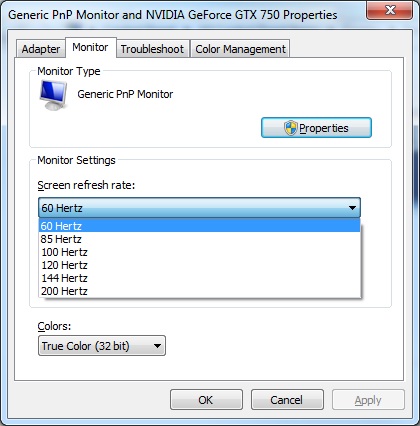
Above: Windows
refresh rate settings once overclocking has been enabled in
the OSD menu
Once it has restarted, you will see additional
refresh rate settings available in Windows to choose from. You simply just
select the setting you want and that's it! The active resolution and refresh
rate are confirmed in the information section of the OSD menu as well.
We had no issues with running at any of these
refresh rates from our tests system, using an NVIDIA GTX 750 graphics card. All
of them were detected properly and worked fine in Windows with no visible
artefacts or flickering. Some users had reported some coil whine from the smaller X34 screen when using overclocked
refresh rates on the but we heard nothing different at any refresh rate here on
the Z35, or indeed when we tested the X34.
If you have a really obvious
whine from the screen which is an issue for you, we would suggest contacting
Acer for an RMA as that doesn't seem to be an issue affecting every sample.
Certainly ours was fine.
Most importantly, we tested
the screen using the
BlurBusters.com frame skipping test and were very pleased to see that no
frames were dropped at all, even at the maximum 200Hz refresh rate. This
overclocking seemed to work very well, at least from our test systems (both
NVIDIA GTX 750 and AMD Radeon R9 290 series) and we were
impressed.
One thing we did notice on our NVIDIA test system
was an odd behaviour with the overdrive impulse at the maximum 200Hz refresh
rate. If you observe the moving car in the PixPerAn tests you can see this
issue. Approximately every 3 seconds the overdrive impulse seemed to "jump",
causing a large amount of overshoot to momentarily appear in front of the moving
object, before quickly reverting to its normal operation. It was a very quick
change but you could see it clearly. At 200Hz and with OD set to normal there is
some dark trailing behind the car normally. This disappears momentarily and a
more severe dark and pale overshoot appears in front of the car instead. It was
an odd behaviour and we can only assume it was an artefact resulting from the
excessive refresh rate boost above the native 144Hz. At 160 and 180Hz
overclocked refresh rate modes this did not appear, so it seemed to be only when
pushing the screen to the limit of its refresh rate overclock. Perhaps this will
vary on other systems and graphics cards although we found it did the exact same
thing on our AMD Radeon system as well.
As we've already discussed though, we felt the
overshoot became too noticeable when you start to get above 120Hz so we
would question the practical use of these higher refresh rates. 120Hz is still a
very decent refresh rate and should offer smooth motion and high frame rates.
The refresh rates above this introduce too many issues we felt and so might not
be much use to some users. If you're
using G-sync as well, you would probably be best sticking with either 120Hz
maximum or the native 144Hz as the maximum refresh rate, rather than using any
overclocked settings, and allowing the G-sync module to dynamically control the
refresh rate between 30 - 120/144Hz.

More Detailed Measurements
OD Normal, 120Hz Refresh Rate
Having established that the OD normal setting
offered the best response/overshoot balance we carried out our normal wider
range of measurements as shown below. We used a refresh rate of 120Hz since that
in our opinion it delivered the optimal response time performance without too much
overshoot and dark smearing being introduced. You can of course push the refresh
rate up to the native 144Hz or even one of the overclocked settings up to 200Hz.
This brings the response times down a bit, but we felt the overshoot trade-off
was not worth it.
 
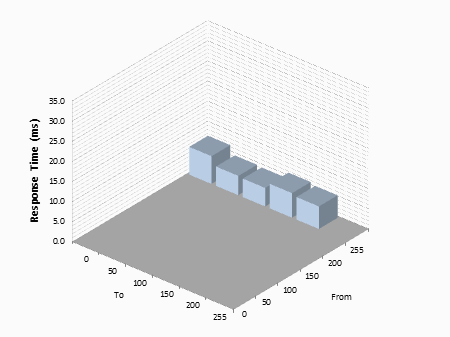
The average G2G response time was more accurately
measured at 9.0ms which was not bad overall for a VA panel. There are some
transitions which are problematic, those changing from black to grey shades. You
can see for instance that the 0-50 transition is extremely slow at 51.5ms, then
they get a little faster as the grey shade becomes lighter. These slow response
times drag the average down a lot though, and in fact if you ignore those 4 in
red/orange, the response times would have been 5.7ms G2G average which would
have been excellent. With some slow transitions plaguing the panel, some
smearing and blurring is evident in practice. The 120Hz refresh rate used here
provides a high frame rate and brings about some motion blue reduction benefits
compared with lower refresh rates. It also does boost the response times
somewhat compared with 60Hz and 85Hz for instance so there's an obvious benefit
in running at 120Hz here. If you push the refresh rate up higher, there are some
small improvements in response time measurements (although not massive), however
at the cost of more noticeable overshoot artefacts.
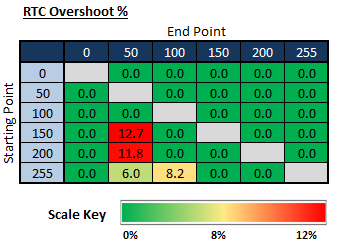
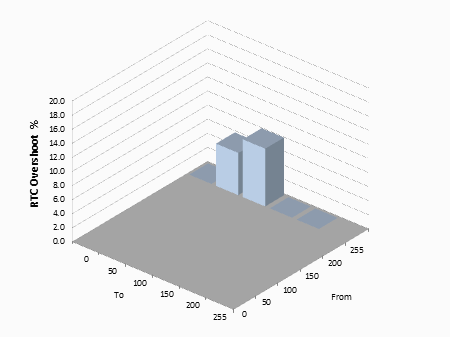
At 120Hz there was very little overshoot, with
only a couple of transitions showing anything, and even then at fairly low
levels. Once again we felt that 120Hz provided the optimum balance between
response times and overshoot. If you push the refresh rate higher, the overdrive
impulse is dynamically affected and boosted to try and ensure the response times
can keep up with the frame rate demands. In doing so, above 120Hz we saw a
progressively more noticeable dark trailing and smearing introduced. By the time
you reach overclocked refresh rates it is distracting and problematic. We think
120Hz would provide the best balance for many users. Not to mention this
is then a much lower demand on your system and graphics card than trying to
output 2560 x 1080 @ 200Hz.

Display Comparisons
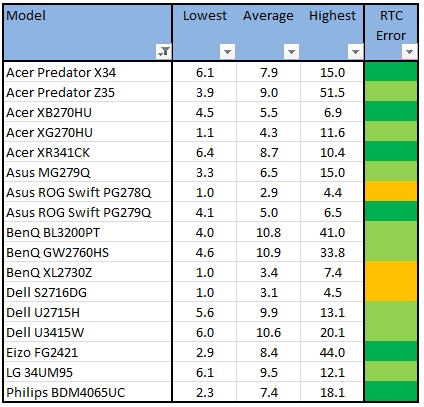
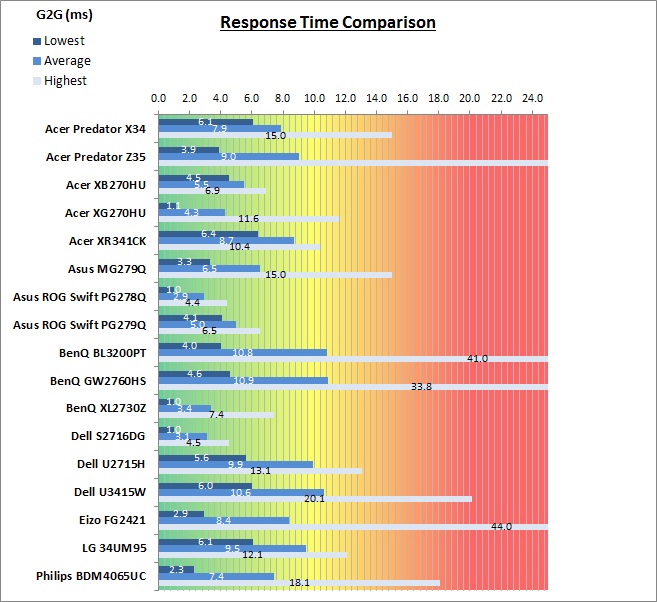
The above comparison table and graph shows you the
lowest, average and highest G2G response time measurement for each screen we
have tested with our oscilloscope system. There is also a colour coded mark next
to each screen in the table to indicate the RTC overshoot error, as the response
time figure alone doesn't tell the whole story.
When using the screen at the optimal 120Hz refresh
rate the response times out-performed other recent VA panels like the BenQ
BL3200PT and GW2760HS by a little way, and there were obviously significant
improvements in refresh rate support compared with those 60Hz-only models. The
VA based
Eizo Foris FG2421 was a bit faster overall though but not by a huge amount.
Motion clarity wise, you could say the Predator Z35 is quite like having a 35"
ultra-wide version of that Eizo screen in many ways in practice. Response times
and motion clarity couldn't keep up with the range of modern high refresh rate
IPS-type panels like the Acer XB270HU (5.5ms) or Asus ROG Swift PG279Q (5.0ms)
for instance. Nor could it keep up with fast TN Film screens like the BenQ
XL2730Z (3.4ms).
The screen was also tested using the chase test in
PixPerAn for the following display comparisons. As a reminder, a series of
pictures are taken on the highest shutter speed and compared, with the best case
example shown on the left, and worst case example on the right. This should only
be used as a rough guide to comparative responsiveness but is handy for a
comparison between different screens and technologies as well as a means to
compare those screens we tested before the introduction of our oscilloscope
method.

35"
4ms
G2G AU Optronics AMVA @ 120Hz (OD = Normal)
In practice the Acer Predator Z35 performed best with
OD at normal and at 120Hz refresh rate. There were moderate levels of blurring evident,
and there was only low levels of overshoot evident. The support for higher refresh rates provided additional levels of motion clarity and image smoothness which
surpassed what was possible from 60Hz VA panels certainly. The additional G-sync
and ULMB support for
NVIDIA users will also be of real benefit.

35"
4ms
G2G AU Optronics AMVA @ 120Hz (OD = Normal)

34"
4ms
G2G LG.Display AH-IPS @ 100Hz (OD = Normal)

34"
4ms
G2G LG.Display AH-IPS @ 75Hz (OD = Normal)
The above images show a comparison with the 34"
Acer Predator X34 (G-sync) and
Acer XR341CK models (FreeSync version). The two 34" models showed less
noticeable blurring we felt and better motion clarity. A result of improved
response times (more so with the X34), freedom from the low levels of overshoot
we saw on the Z35 and also without the issues of some particularly slow
transitions which affected the VA panel of the Z35.

Ultra Low Motion Blur (ULMB)
The Predator Z35 also features an integrated Blur
Reduction Backlight system, dubbed "Ultra Low Motion Blur" (ULMB).
This is linked to the G-sync module and is provided on most G-sync enabled
screens that have a native high refresh rate. We have
already seen a lot of positive improvements in perceived motion blur from such
systems in the past. Our
in depth article from June 2013
(updated 17 March 2015) looked at this in a lot
more detail, and tested some of the original LightBoost "hacks" to achieve a
strobed backlight and blur reduction benefits. Since then we've seen a quite a
lot of
monitors integrate a strobed backlight with simple user control from the
menu and with better implementation than LightBoost methods.
The ULMB feature is accessible from the 'display'
section of the OSD menu. It is only available when running the
screen at 85, 100 and 120Hz modes. It is not available at 144Hz or any of the
overclocked refresh rates. It is also important to note that ULMB does not
work when you are using G-sync, it's one or the other. When you enable the ULMB
feature a new option appears for the "Pulse Width" which allows you to
control the duration of the backlight strobes. A shorter "on" period can help
reduce perceived motion blur even more, but at the cost of screen brightness. You can adjust this between 100 and 10, and as you lower the setting
the screen also becomes progressively darker as you reduce the "on" period of
the strobe. Nice to see this included as an option within the menu for those who
like to play around with the setting, much like you could do by adjusting
LightBoost levels on older models using the
"hack" method. There is no control to adjust the timing of the strobe to
impact the strobe cross-talk it can introduce, so we will have to hope that the default
timing setup is suitable.
Operation - 85Hz
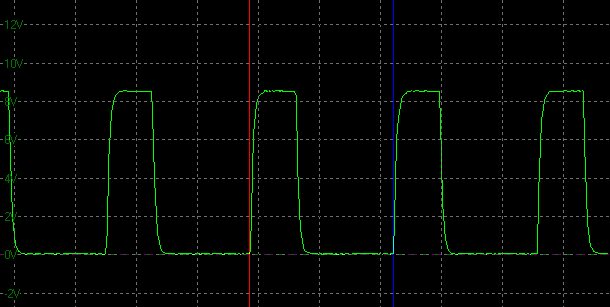
ULMB
backlight cycling, 85Hz
(scale = 5ms)
pulse width setting= 100
We measured the screen using our oscilloscope when
viewing a solid white image, with ULMB feature turned on and with
refresh rate set at 85Hz. This is the lowest refresh rate at which you can
operate the ULMB mode. As a reminder, it works at 85, 100 and 120Hz only. We
left the pulse width (strobe length) setting at 100 initially. Normally the oscillograph would show a flat straight
line when measuring a static white image (as no PWM is being used for backlight
dimming), but here the ULMB feature is cycling the backlight off and
on rapidly.
The time for each complete cycle is 11.76ms which
shows that in this case the backlight is being cycled at the same frequency as
the refresh rate, 85 times per second. The strobe is in time with the refresh
rate of 85Hz. We actually found the flicker produced by this relatively low
frequency strobe noticeable with the naked eye and a bit annoying. We suggest
using at least 100Hz to avoid most of that.
Operation - 100Hz
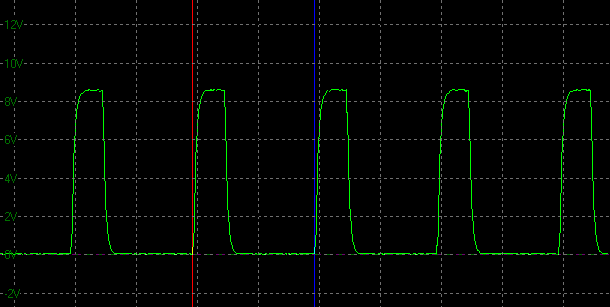
ULMB
backlight cycling, 100Hz
(scale = 5ms)
pulse width setting = 100
When running the screen at a 100Hz refresh rate
the behaviour is exactly the same. The only difference is that the strobe is now
synced with the new refresh rate, with a new strobe every 10ms (100 times per
second).
Operation - 120Hz
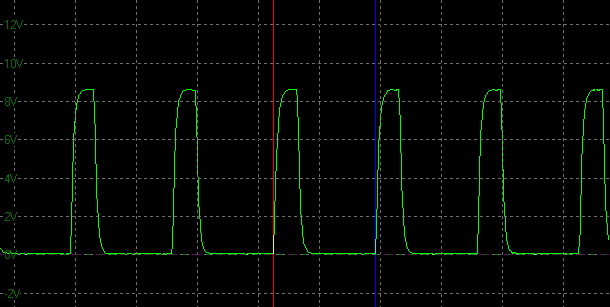
ULMB
backlight cycling, 120Hz
(scale = 5ms)
pulse width setting = 100
Again when set at 120Hz refresh rate the strobes
are in sync again, with a new strobe every 8.33ms (120 times per second). The
above is with pulse width at the default 100. We can also see what impact on the
strobing it has if you lower the pulse width setting.
As you reduce the pulse width setting you are
adjusting the 'on' period of the strobe. This impacts the perceived blur somewhat, with the shorter 'on'
times resulting in a clearer image. At the same time though the brightness of
the image is affected and it becomes very dark, the lower you go with the
setting. More on that in a moment. There will be a point where the user does not
see any further benefit to their eyes of reducing the strobe length further, but
you can have a play around with the setting to find your personal preference to
balance perceived motion blur and brightness of the image.
Pulse Width Setting - Strobe Length
We measured the strobe length at a variety of the
Pulse Width settings, while running at the maximum 120Hz refresh rate mode. You
can adjust the setting in steps of 1 incidentally. Each complete strobe lasts a
total of 8.33ms (120 strobes per second). This strobe timing was exactly the
same as we'd seen on other ULMB-enabled monitors at 120Hz including the
Asus ROG Swift PG278Q and
PG279Q for instance and so is likely fixed for the NVIDIA ULMB feature at
this refresh rate.
|
Pulse Width
Setting |
On period (ms) |
|
100 |
1.875 |
|
75 |
1.375 |
|
50 |
0.875 |
|
25 |
0.500 |
|
10 (min) |
0.250 |
Pulse Width Setting - Brightness Range (120Hz)
|
Pulse Width
Setting |
Luminance
(cd/m2) |
Black
Point (cd/m2) |
Contrast
Ratio
( x:1) |
|
100 |
110.73 |
0.05 |
2215 |
|
75 |
83.31 |
0.04 |
2083 |
|
50 |
53.03 |
0.03 |
1868 |
|
25 |
28.22 |
<0.02 |
- |
|
10 (min) |
11.42 |
<0.02 |
- |
We tested the brightness output of the screen when
ULMB was turned on at 120Hz. You can independently control the brightness setting as well
if you want, but we left it at the default 100 and just changed the pulse width
(PW) strobe length setting to establish the brightness range when using this
option. With the PW setting at 100 the maximum achievable luminance of the
screen was a moderate 111
cd/m2. This
should be enough for some uses, but you cannot get a brighter display when
using ULMB if you wanted to. This is a typical performance from a strobe
backlight anyway and represented a decent enough luminance level for the
majority of users.
You can achieve a slightly brighter display if you
use the feature at 85 or 100Hz since the strobes are less frequent, but it's not
a significant amount.
As you reduce
the PW setting the luminance drops significantly, at the lowest setting probably
being far too dark for any practical use. At least you can control a reasonably
wide range here, so you can find a level which suits your needs. We suspect a
setting of 100 will probably be adequate for most normal users anyway, as the
ULMB mode certainly brings about positive improvements to the perceived motion
blur.
Brightness Range (PW at 100, 120Hz)
|
Brightness Setting |
Luminance
(cd/m2) |
Black
Point (cd/m2) |
Contrast
Ratio
( x:1) |
|
100 |
110.73 |
0.05 |
2215 |
|
75 |
89.53 |
0.05 |
1791 |
|
50 |
66.17 |
0.03 |
2206 |
|
25 |
39.61 |
0.02 |
1980 |
|
0 |
8.73 |
<0.02 |
- |
We also wanted to test the brightness range when
leaving PW at its default 100, and changing the brightness control of the screen
instead. This leaves the strobe behaviour alone, operating as it does with PW at
100, and instead just dims the backlight. The table above confirms the range available through that control.
You can achieve a slightly brighter display if you use the feature at 85 or
100Hz since the strobes are less frequent, but it's not a significant amount.
When you enable the ULMB feature the actual
brightness level showing in the OSD menu is still the same as whatever you had
it set at before (let's say our calibrated 21% for arguments sake). So the menu
shows 21% still but in fact when you first enable ULMB it operates with maximum
brightness for that feature. If you then turn off ULMB it reverts back to the
21% brightness you had before. So that part is good and doesn't cause any
problems. If for some reason you wanted to run the ULMB at a lower brightness
setting you'd have to manually change it from the 21% showing in the menu to
whatever level you wanted (let's say 90%). When you then turn off ULMB the
brightness stays at that new 90%. We can't really see any need to run at
anything less than 100% when using ULMB so actually it all works nicely. Just
leave the brightness control alone in the OSD and it will switch from your
normal calibrated setting to 100% brightness ULMB, and then back again nice and
easily. If for any reason you wanted a darker ULMB operation we recommend just
lowering the pulse width setting a bit which then doesn't affect the brightness
control, and also will bring about some minor improvements in blur reduction
too.
Maximum Blur Reduction Brightness - Display
Comparison
For ease of reference we have
also provided a comparison table below of all the blur reduction enabled
displays we've tested, showing their maximum luminance before blur reduction is
turned on (normal mode) and their maximum luminance with the feature enabled.
This will give you an idea of the maximum brightness you can expect from each
model when using their blur reduction feature, if that is important to you. A
lot of people want a brighter display for gaming and sometimes the relatively
low maximum luminance from blur reduction modes is a limitation.
These comparisons are with the refresh rate as
high as is available for the blur reduction feature to function. For most this
is at 120Hz, but some also support the feature at higher. You can achieve a
slightly brighter display if you use the feature at 85 or 100Hz since the
strobes are less frequent, but it's not a significant amount. That can also
introduce more visible flicker in some situations.
|
Model |
Refresh Rate |
Max Normal Luminance
Blur Reduction Off
(cd/m2) |
Max Luminance
Blur Reduction On
(cd/m2) |
|
Acer XB270HU* |
100Hz* |
327 |
111 |
|
Acer Predator Z35 |
120Hz |
359 |
111 |
|
Asus ROG Swift PG278Q |
120Hz |
385 |
123 |
|
Asus ROG Swift PG279Q |
120Hz |
331 |
101 |
|
BenQ XL2720Z |
144Hz |
282 |
119 |
|
BenQ XL2730Z |
120Hz |
309 |
191 |
|
Dell S2716DG |
120Hz |
328 |
118 |
|
Eizo FG2421 |
120Hz |
386 |
257 |
Note:
Pulse Width setting at max where applicable.
*Note 2: The Acer XB270HU was later updated to include a 120Hz mode, which will produce a
slightly darker maximum luminance
Blur Reduction Tests
Of course the main thing we want to test is what
improvements the Blur Reduction mode offers when it comes to motion clarity and
gaming. We were pleased with the results we'd seen from LightBoost backlights
when we tested them, and also from the natively supported blur reduction
feature on other displays
we've tested.
We were very pleased with the results
here as we had been on other blur reduction displays, with an obvious and marked improvement in perceived motion blur experienced.
Tracking of moving objects became much easier and the image looked sharper and
clearer. Some of the dark smearing we had seen before was cut off by the
strobing of the backlight and the motion clarity was certainly much better. We used the BlurBusters full-screen
TestUFO online motion test as well to put the
feature through its paces and were pleased with the results. The upper half of
the screen was a little clearer than the bottom, and in the bottom third of the
screen some strobe cross-talk became apparent. It is impossible to eliminate
strobe cross-talk completely due to the way they operate, but the important
thing is whereabouts on the screen this manifests itself and to what level. The
central region is probably the most important since that's where a lot of your
gaming focus will be, where crosshairs and the likes are. We were pleased that
there was low levels of cross-talk here in the central region and the image looked
pretty good. It wasn't as clear as some other screens we've tested since the
response times are not as good, but it's a marked improvement over normal
operation for sure. Having the ability to alter the strobe length through the PW setting
was also very useful, and you could tweak it to your preference to reduce even
more
of the persistence if you wanted, as long as you didn't mind sacrificing some
brightness. As ever, you cannot use ULMB at the same time as G-sync so keep that
in mind.

Additional Gaming Features
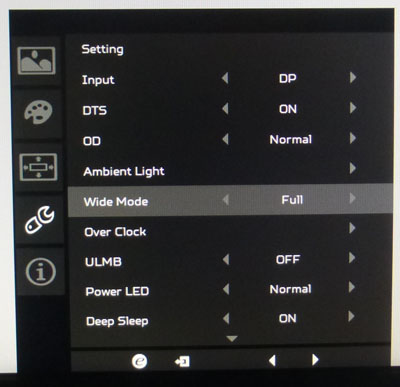
-
Aspect Ratio Control -
The Z35 has 3 options listed in the menu for
aspect ratio control through the OSD 'setting' section menu. There are options for
full, aspect
and 1:1 pixel mapping. However, these didn't seem to work when we tested them.
If you run at anything other than the native resolution, the aspect ratio is
maintained. e.g. a 1920 x 1080 resolution has black borders on the sides.
However, the 1:1 pixel mapping didn't seem to do anything, the image always just
filled as much of the screen as possible. With the aspect ratio at least being
maintained it was not a problem though as that's the main thing.

Lag
We have written an in depth article about
input lag and the various measurement techniques which are used to evaluate
this aspect of a display. It's important to first of all understand the
different methods available and also what this lag means to you as an end-user.
Input Lag vs. Display Lag vs. Signal
Processing
To avoid confusion with different terminology we
will refer to this section of our reviews as just "lag" from now on, as there
are a few different aspects to consider, and different interpretations of the
term "input lag". We will consider the following points here as much as
possible. The overall "display lag" is the first, that being the delay between
the image being shown on the TFT display and that being shown on a CRT. This is
what many people will know as input lag and originally was the measure made to
explain why the image is a little behind when using a CRT. The older stopwatch
based methods were the common way to measure this in the past, but through
advanced studies have been shown to be quite inaccurate. As a result, more
advanced tools like SMTT provide a method to measure that delay between a TFT
and CRT while removing the inaccuracies of older stopwatch methods.
In reality that lag / delay is caused by a
combination of two things - the signal processing delay caused by the TFT
electronics / scaler, and the response time of the pixels themselves. Most
"input lag" measurements over the years have always been based on the overall
display lag (signal processing + response time) and indeed the SMTT tool is
based on this visual difference between a CRT and TFT and so measures the
overall display lag. In practice the signal processing is the element which
gives the feel of lag to the user, and the response time of course can
impact blurring, and overall image quality in moving scenes. As people become
more aware of lag as a possible issue, we are of course keen to try and
understand the split between the two as much as possible to give a complete
picture.
The signal processing element within that is quite
hard to identify without extremely high end equipment and very complicated
methods. In fact the studies by Thomas Thiemann which really kicked this whole
thing off were based on equipment worth >100,1000 Euro, requiring extremely high
bandwidths and very complicated methods to trigger the correct behaviour and
accurately measure the signal processing on its own. Other techniques which are
being used since are not conducted by Thomas (he is a freelance writer) or based
on this equipment or technique, and may also be subject to other errors or
inaccuracies based on our conversations with him since. It's very hard as a
result to produce a technique which will measure just the signal processing on
its own unfortunately. Many measurement techniques are also not explained and so
it is important to try and get a picture from various sources if possible to
make an informed judgement about a display overall.
For our tests we will continue to use the SMTT
tool to measure the overall "display lag". From there we can use our
oscilloscope system to measure the response time across a wide range of grey to
grey (G2G) transitions as recorded in our
response time
tests. Since SMTT will not include the full response time within its
measurements, after speaking with Thomas further about the situation we will
subtract half of the average G2G response time from the total display lag. This should allow us to give a good estimation of
how much of the overall lag is attributable to the signal processing element on
its own.
Lag Classification
To help in this section we will also introduce a broader classification system
for these results to help categorise each screen as one of the following levels:
-
Class 1)
Less than 16ms / 1 frame lag at 60Hz - should be fine for gamers, even at high levels
-
Class
2)
A lag of 16 -
32ms / One to two frames of lag at 60Hz - moderate lag but should be fine for many gamers.
Caution advised for serious gaming and FPS
-
Class
3)
A lag of more
than 32ms / more than 2 frames of lag at 60Hz - Some noticeable lag in daily usage, not
suitable for high end gaming
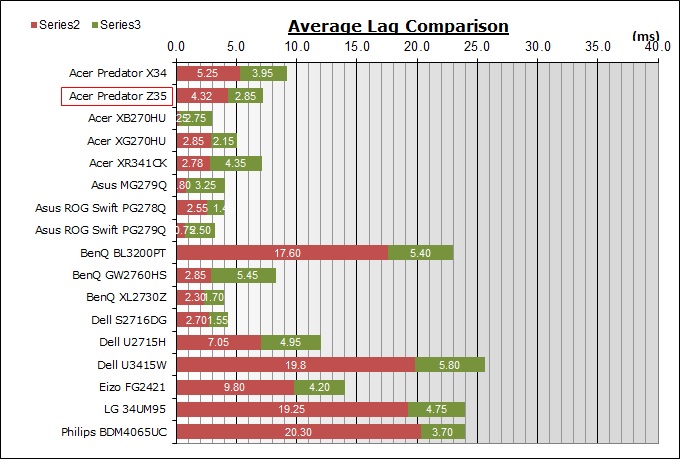
For the full reviews of the models compared here and the dates they were written
(and when screens were approximately released to the market), please see our
full
reviews index.
|
(Measurements in ms) |
|
|
Total Display Lag (SMTT
2) |
7.17 |
|
Pixel Response Time
Element |
2.85 |
|
Estimated Signal
Processing Lag |
4.32 |
|
Lag Classification |
1 |
|

Class 1 |
We have provided a comparison above against other
models we have tested to give an indication between screens. The screens
tested are split into two measurements which are
based on our overall display lag tests (using SMTT) and half the average G2G
response time, as measured by the oscilloscope. The response time is split from
the overall display lag and shown on the graph as the green bar. From there, the
signal processing (red bar) can be provided as a good estimation.
The screen showed a total lag of only 7.17ms.
Approximately 2.85ms of that can be accounted for by pixel response times (if we
ignore the few very slow transitions and take half of the 5.7ms G2G average we
are left with),
leaving an estimated signal processing lag of only 4.32ms. This is basically
nothing and means the screen should be fine for all levels of gaming. Other
G-sync screens to date have shown similar very low levels of lag which is
pleasing.

Movies and Video

The following summarises the screens performance
in video applications:
-
35"
screen size makes it a good option for an all-in-one multimedia screen, and
pushing towards the diagonal size of a lot of smaller end LCD TV's even.
-
21:9
aspect ratio is well suited to videos and particularly movies, leaving smaller
borders on DVD's and wide screen content at the top and bottom. The ultra-wide
aspect and size is well-suited to watching movies and really works well.
-
2560 x
1080 resolution can support full 1080 HD resolution content.
-
Digital interfaces support HDCP for any encrypted and protected content
-
HDMI and DisplayPort connections available.
Nice to see HDMI connectivity included for modern DVD players, Blu-ray,
consoles etc thanks to the use of G-sync v II here.
-
Cables provided in the box
for HDMI and DisplayPort.
-
Light
AG coating provides clear images with no major graininess, and without the
unwanted reflections of a glossy solution.
-
Wide
brightness range adjustment possible from the display, including high maximum
luminance of 359
cd/m2 and a good minimum luminance of
54 cd/m2. This should afford you very good control for different
lighting conditions. Brightness regulation is controlled without the need for PWM and so
is flicker free at all settings which is pleasing.
-
Black
depth and contrast ratio are very good thanks to the VA-type panel at 2813:1
after calibration. Detail in darker scenes should not be lost as a result and
this is certainly a strength of the VA panel technology used here.
-
There
is a specific 'movie' eColor preset mode available for movies or video in the
OSD which is basically just preset brightness level. You might be better
setting up the screen to your liking and saving it then as one of the 3 user
defined game modes.
-
Adequate pixel responsiveness which should handle fast moving scenes in movies
without issue. No overshoot issues as long as you stick to 120Hz or less and
the 'Normal' OD setting. You may see issues with smearing in certain scenes
caused by some slow response times in places.
-
High
refresh rate improves fluidity of moving images and reduces perceived blurring
to a degree.
-
Viewing angles are a little behind what we were
hoping for and there is noticeable gamma and colour tone shift as you change
your viewing position. The image becomes quickly washed out so we wouldn't
advise using this screen for viewing from anything other than head on really.
There is at least no pale IPS-glow on dark content like you see from the
majority of IPS-type panels.
-
Some
slight areas of backlight leakage but nothing major on our sample which is
good. Some uniformity variations may be visible on darker movie scenes in
darkened room conditions.
-
Pretty good range range of ergonomic adjustments
available from the stand, making it fairly easy to position the screen in
different ways for viewing from different positions. They were stiff to move
and the screen is heavy, so you won't want to move it around too often. The
lack of side to side swivel was a bit of a shame though.
-
Integrated 2x 9W DTS sound stereo speakers offered on this model, may be ok for the odd
video clip but probably not for any movie viewing.
-
There
are options for hardware aspect ratio control, but they don't seem to function
properly from our testing. They do at least maintain the source aspect ratio
which is the main thing, so that should work fine for external devices which
commonly operate in 16:9 format.
-
Picture By Picture (PbP) and Picture In Picture (PiP) are not available on
this model.

Conclusion
We know how excited people were to get a
detailed review of this monitor as quickly as possible, so we decided to release
this as a full review straight away. We
worked overtime to bring you this quickly as well so if you appreciate the early
access to the review and enjoy reading and like our work, we would welcome a
donation
to the site to help us continue to make quality and detailed reviews for you.
The Z35 is certainly an interesting screen to
consider, and with its massive 35" ultra-wide screen size it is a real beast of
a monitor. Being as big as it is, and with a considerable curve it is very
immersive for gaming and multimedia and these are certainly the screens primary
target uses. We were impressed by the decent range of features and extras
offered by this model. NVIDIA G-sync and ULMB are of course very welcome and offers great
benefits for gaming. Added features like the ambient light system were also nice
extra touches we felt. Performance wise it's quite interesting as VA panels are
rarely used in gaming screens and this is one of the few available. The
high refresh rate offers a big bump in frame rates and performance over the wide
range of 60Hz-only VA panels available so far, so that's an obvious selling
point here. Thanks to the G-sync module the lag was basically non-existent as
well which was positive. VA technology certainly has it's advantages when it
comes to contrast ratio, offering deep blacks and also the freedom from the pale
glow you see from IPS panels in darker content.
In other aspects of gaming the screen struggled a
bit though. The response times were ok overall but some transitions caused
problems and were very slow. You end up with obvious dark smearing and blurring
in certain circumstances which is a shame, and at the moment a limitation of VA
technology it seems. The additional ULMB was very good at improving motion
clarity and did help cut back some of that smearing if you want to use that
feature. The very high refresh rates enabled by the overclocking feature
couldn't really be fully realised though sadly, as we felt that response times
were just not fast enough to handle the frame rate demands, and the overshoot
introduced by the aggressive overdrive circuit was too obvious. It's still very
capable as a VA option with a high refresh rate of 120Hz, with G-sync and ULMB
support but the 200Hz overclocking feature couldn't quite keep up sadly.
In other non-gaming areas the low resolution and
large font size aren't great for office work, unless maybe you're used to low
DPI already. However, the backlight offered a good range of adjustment and the flicker
free operation was definitely pleasing. Default setup was also decent and
required little change to achieve a reliable performance. Viewing angles were
not as good as we were expecting sadly. The feature set was reasonable, with a
fair set of connectivity options and stand adjustments provided and in line with
other modern G-sync screens.
Overall if you are after a VA screen for gaming
this is certainly one of the best options available. VA technology isn't quite
there it seems to keep up with some of the impressive specs and features
available, but it's still very capable and provides plenty of performance power
in many areas.
|
Pros |
Cons |
|
High contrast ratio and deep
blacks from VA panel |
Some blurring and smearing a
problem due to some slow response times |
|
NVIDIA G-sync and ULMB support
along with low lag are great for gaming |
Refresh rates >120Hz not
really practical |
|
Decent default setup |
Viewing angles not great |
|
Check Pricing and Buy - Direct Links
|
|
Amazon USA |
Amazon UK |
Overclockers UK |
Amazon GER |
Amazon CAN
|
|
TFTCentral is a participant
in the Amazon Services LLC Associates Programme, an affiliate
advertising programme designed to provide a means for sites to earn
advertising fees by advertising and linking to Amazon.com, Amazon.co.uk,
Amazon.de, Amazon.ca and other Amazon stores worldwide. We also
participate in a similar scheme for Overclockers.co.uk. |
|